#sports history
Text

Trans Jewish tennis player Renée Richards photographed during an interview in 1976
Renée was outed in the process of her transition in 1976 by local TV anchor Richard Carlson (father of Tucker Carlson) and in reaction the US Tennis Association, the Women’s Tennis Association, and the US Open Committee began requiring all female competitors to verify their chromosomes with a Barr body test. (Male competitors were not included, as this rule was implemented to ostracize one woman in particular.)
Renée was barred from competing in the 1976 US Open, Wimbledon, and the Italian Open due to refusing to be tested. She took the USTA to court for gender discrimination, relenting to taking the test during the trial. The results were ambiguous and she refused to be re-tested, and was again barred from play. She won the case in the Summer of 1977, with the judge ruling they had intentionally discriminated against her and that she be allowed to play in the US Open.
#op#photography#renée richards#tennis#sports history#trans history#trans women in sports#trans women#jewish trans women#1970s#1976
1K notes
·
View notes
Text
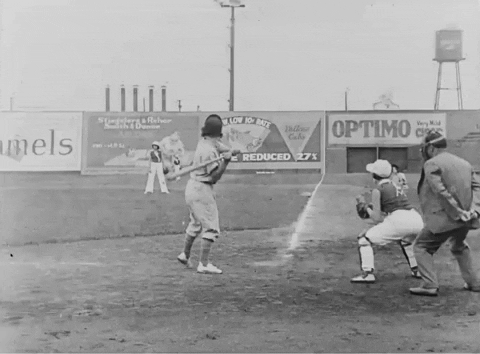
⚾ Before #WWII, women played #baseball in junior and minor leagues throughout the United States. In 1930, Universal News highlighted a "All-Girls Teams in Slug-fest," a game played between Niles and Oakland. ⚾
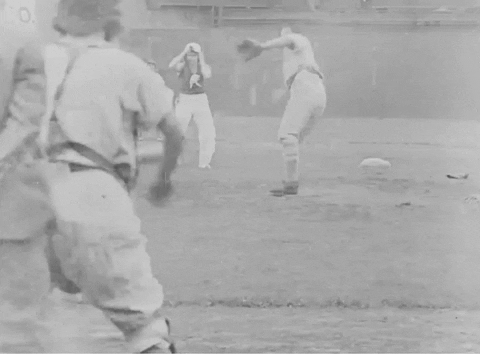
#openingday#baseball#opening day#women's history#women's history month#sports history#sports#baseball history#national archives#women's sports#women's baseball
130 notes
·
View notes
Note
I assume you heard of what the Real Madrid twitter account posted, how Franco was a supported of Barça? Amazing historical revisionism, as if Catalans weren't tortured or murdered for daring to speak their language, or how even one of the directors of Barça was murdered after being accused of defending the independence of Catalonia.
I'm sure they are aware they're lying, I don't believe someone would be so ignorant to make up something like that and somehow convince themselves of it.
Basically, if someone's not aware of what happened, Real Madrid published a video saying that FC Barcelona (Barça) was favoured by the Spanish fascist dictator Franco, which is false. The team that has always been associated with Francoist beliefs is Real Madrid, so I assume they want to distance themselves from that by accusing their main rival (Barça), who also happens to be a symbol of a minority (Catalans) that was one of the main groups targeted by Spanish fascism.
Some actual historical information about Franco and Barça:
1. In 1939, all football clubs that were federated in the Catalan Federation were banned from playing. All the players' contracts were cancelled. That includes Barça. Some months later, they were reformed and could continue existing with a completely different directors/administration board accepted by the regime. (Women are banned from this position, when Barça had la Sagi.) Copying the model of Mussolini's Italy, the Francoist dictatorship gave control of sports to the Falange (the fascist party, the only party allowed) who controlled everything from the Delegación Nacional de Deportes (National Sports Delegation).
2. For the previous resolution, all of Barça's administratives are ceases and their names and files are given to the military police to control them. The board and administration of all the club was purged.
3. The regime sentenced to death and killed the president of Barça at the time (Josep Sunyol i Garriga) for being pro-Catalan.
The president of Real Madrid (Antonio Ortega) was also killed for being a communist. The difference is that nowadays, since the end of the dictatorship, Barça honours Josep Sunyol, while Madrid acts as if Antonio Ortega had never existed and doesn't have any space dedicated to him. Not only that, but if you look at Real Madrid's website, they leave an empty spot during the years that Antonio Ortega was president (1936-1939), pretending he never was and there simply was no president during those years.
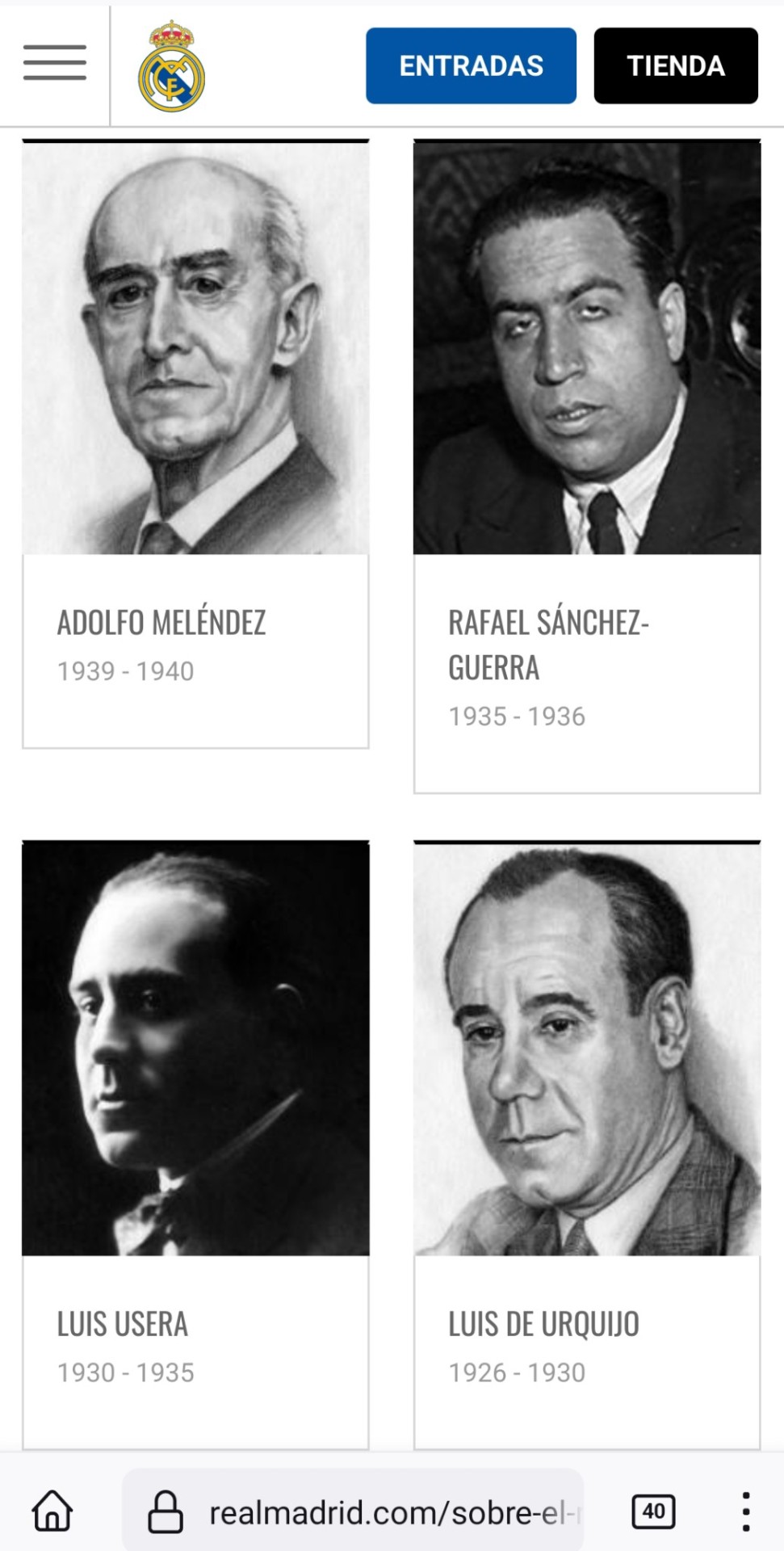
All the opposite, Real Madrid honours Santiago Bernabéu (the team's stadium is named after him), who worked to bring Real Madrid closer to the dictatorship. Even before Franco gained power, in the 1920s, he said that Real Madrid defends "the Spanish pride and cause". He later enlisted in the Spanish army and joined the fascists in their coup d'etat that led to the Spanish Civil War.
4. Barça had to change their entrance tickets and their name to Spanish following Franco's illegalization of the Catalan language. It stoped being called "Futbol Club Barcelona" (Catalan) and had to be called "Club de Fútbol Barcelona" (Spanish). Consequently, the letters in the club's shield were consequently changed from F.C.B. to C.F.B. The club wouldn't get their original Catalan name back until 1973.
5. Removed the Catalan flag from Barça's shield. They had to have 2 red bars instead of the 4 bars of the Catalan flag. Later they could get it back because Barça's shield is based on the shield of the city of Barcelona, so they alleged it's just a symbol of the city.
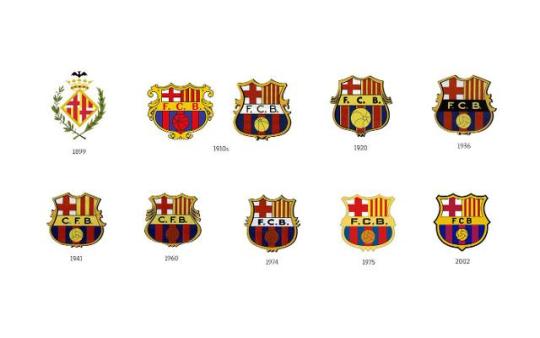
6. Instrumentalized Barça and Athletic de Bilbao against Catalan and Basque people, since the regime identified Barça and Athletic de Bilbao as the teams that symbolise these two minority nations and their independentism. Their first match after the war was scheduled by the regime, a Barça vs Athletic de Bilbao where the whole stadium was wrapped in huge Spanish flags and were various fascist gave speeches in favour of Franco and Spanish unity, including the general Álvarez-Arenas who talked about the purges by saying he praised Barça for "having thrown away forever the anti-Spanish seed, exposing their idea of what sport entities must be patriotically, the true healthy sport to educate the masses" ("que ha sabido arrojar para siempre la semilla de los antiespañoles, exponiendo su idea de lo que patrióticamente han de ser las entidades deportivas, el verdadero n del deporte sano y educativo de multitudes").
7. The regime abolished the Catalonia League, where Barça played.
8. More purges in Barça followed after that first one. The dictatorship carried out in-depth investigations into Barça's directives and members to find people who fought for Catalan rights. Some people were accused for being in the Barça directive. Here's some extracts from the letter where the leader of the fascist police in Barcelona, Luis Martí Olivares, sent to order the arrest of some Barça directives and to order them to be taken to Madrid for trial:
In front of the statue of Casanovas, they used to celebrate acts of separatist affirmation [...]. All the directives, players and members [of Futbol Club Barcelona] have always attended it with flower crowns, offerings with the shield of the "F.C. BARCELONA"
Another one by him:
It's publicly known that the "F.C. BARCELONA" has always been political, at the beginning pro-Catalan and since a long time ago frankly separatist and for this reason they have exploited their rivalry with R.C.D. ESPAÑOL, which has been precisely the only Football Club in Catalonia that has signified themselves as a true pro-Spanish. In the matches between these two Clubs, the Barcelona fans considered the Spanishists to be foreigners, because they spoke in Spanish.
After the purges, the new dictatorship-approved directive board of Barça was made (for the 1st time in the club's history) of people who were not even members of the club. Many of them were fervent Espanyol fans, not Barça fans.
Most of their first decisions were political, including the fact that they removed the club's founder Joan Gamper as honorary president and declared the new honorary president to be the Spanish fascist general Múgica.
They also made the players taka a flower crown to the founder of Spanish fascism José Antonio Primo de Rivera, which had the Spanish flag and the Barça flag and inscription "F.C. Barcelona to José Antonio".
One of Barça's directors during the dictatorship was actually a paying Espanyol member during his time as Barça president, another director was an army general that was appointed directed by the higher spheres of the dictatorship and who openly said he was directing Barça simply because "as soldier with discipline I'm following orders".
9. Finally, in June 1946, the members of the Barça board who were actually Barça fans and cared for the club mass resigned and pressured the director to stop being a club under direct control of the dictatorship's government. Their protest resulted in the end of the regime's direct intervention, and after 10 years Barça could go back to having a new directive board, this time mostly made up of people who had always been Barça fans, though the regime still only allowed people who were officially approved.
So while Barça was directed by people who didn't care about the club and who were very badly coordinated and later was starting to re-order itself (still only with approved people), Real Madrid had its golden age, under the director Santiago Bernabéu (who was defined as "he's what Philip II was to Spain: its best king" and as we've explained before was a fascist) and a director board that had close ties to the fascist government.
The club that was most favoured by the regime during its first years was Atlético de Madrid (at the time called Atlético Aviación) which was related to the Army. But the president of Real Madrid Santiago Bernabéu got the club closer to the dictatorship and made it become the regime's favourite from the late 1950s on. Real Madrid played a very important role in fascist Spain's public relations, because that's the historical period that ended the autarchy and when fascist Spain was accepted in the UN and kept the dictatorship with the agreement of the other countries. Real Madrid acted as a political and cultural ambassador of fascist Spain in other countries. In return it received favours from the dictatorship. For example, the regime changed the sports clubs' status so that Madrid could hire Alfredo Di Stefano instead of Barça in 1953. Barça had already closed the case and the club and the player were ready to sign, but the dictatorship's direct intervention stopped it.
10. Since speaking Catalan was banned, some Catalan traditions were banned, even some Catalan songs were banned, and everyone was forced to be Spanish and a Spanish nationalist, with the National-Catholic morale imposed in every aspect of life, Barça became the place to express Catalanity. People used to go cheer for Barça as the "allowed"/hidden way of cheering against Francoism and in favour of Catalonia. This sentiment was well represented by the song "Botifarra de pagès" by the Catalan humour band La Trinca, which they released in 1974:
youtube
If you don't speak Catalan, the whole song is about how Catalans cheer for Barça as a representation of cheering for Catalan rights and link how well Barça is doing at the time with Catalanism ("l'any que ve no farem riure, visca Catalunya ------" = "next year we [Barça] won't be laughable, long live free Catalonia!" with a peeeeeep over where the word "free" woul have been) with cultural references. For example, they sing the tempo of sardanes with the name Cruyff, and change the famous quote "som i serem gent catalana, tant si es vol com si no es vol" (we are and we will be Catalan people, wether they want it or not) from the song La santa espina (song forbidden during Franco's dictatorship) with "som i serem socis del Barça, tan si es vol com si no es vol" (we are and we will be Barça fans, wether they want it or not).
11. Regardless of the club's significance to the population (because, let's be honest, everyone knew what Barça meant), it was still a club that existed under a fascist dictatorship. During the dictatorship, only approved or appointed people held office and had the power to take decisions. And if you were in that position were you had been approved, even if you had your secret political beliefs and actions, there was only so much you could do in public before getting fired, arrested, banned for life from your job, get you and your family on a watchlist and likely get tortured.
One of the "unwritten rules" during the dictatorship was that anyone who created a prize or medal had to give the 1st to Franco. Barça did that too, but they have later addressed it and taken it back.
12. In the semifinals of 1942-1943 season, Barça won against Real Madrid by 3-0. On the return match, the dictatorship's police went down to the dressing rooms to intimidate the Barça players so they would let Madrid win. The result was 11-1 (Madrid victory), which effectively gave victory of the league to Real Madrid.
13. Dictator Franco, personally, was a follower of Real Madrid. It's known that he used to comment the lineups with his officers.
---------
Since Real Madrid published that video some days ago, so many Spanish newspapers, magazines and TV channels have talked at length about how Barça actually helped Franco. They use as excuse the fact that the Barça under the dictatorship's control (because remember that the dictatorship chose who would lead the team, even when these people weren't Barça fans it only mattered that they were fascists) gave condecorations to the regime officials. This is worth remembering and worth criticizing, but this says more about the dictatorship than it says about Barça, especially if they want it to represent nowadays Barça. Because the thing is that this is no secret, and Barça has already addressed it in the past: in 2019, Barça officially withdrew all the medals given to Franco officials. Real Madrid still honours fascists and erases their antifascist director, and knows that they're a symbol of Spanish nationalism.
However, it seems like the people who so quickly want to run to talk shit about anything that has to do with Catalonia don't usually keep the same energy to criticize the dictatorship itself and how it intervened every aspect of life, crushing dissidence and national minorities in everything, even their hobbies, nor to make the same criticisms of Real Madrid, because it's not just about Barça but a way to attack Catalan society.
#ask#anonymous#futbol#història#barça#esports#futbol club barcelona#fc barcelona#barca#football#european football#la liga#history#sports history#francoism#1940s#20th century history#spain#barcelona
187 notes
·
View notes
Text
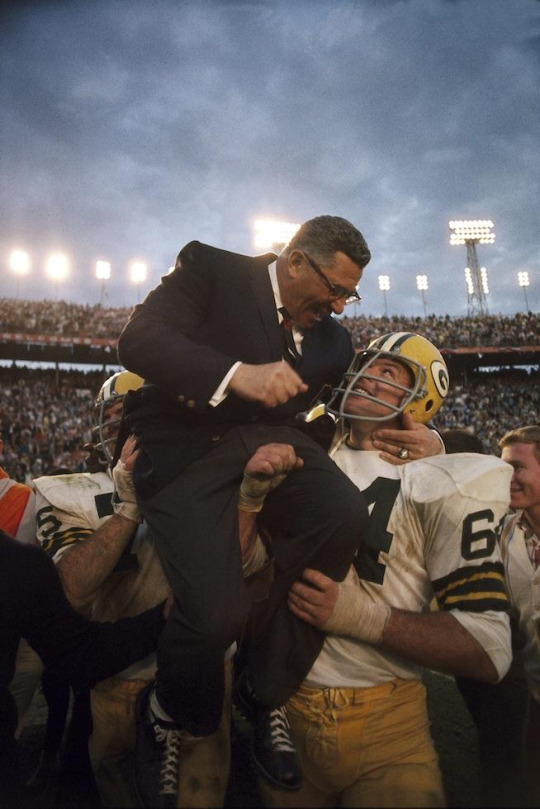

Vince Lombardi is carried off the field by Jerry Kramer of Green Bay Packers (64). Super bowl II 1968
📷 Neil Leifer
#vince lombardi#jerry kramer#neil leifer#sports#super bowl#green bay packers#sports history#american football#football
36 notes
·
View notes
Text
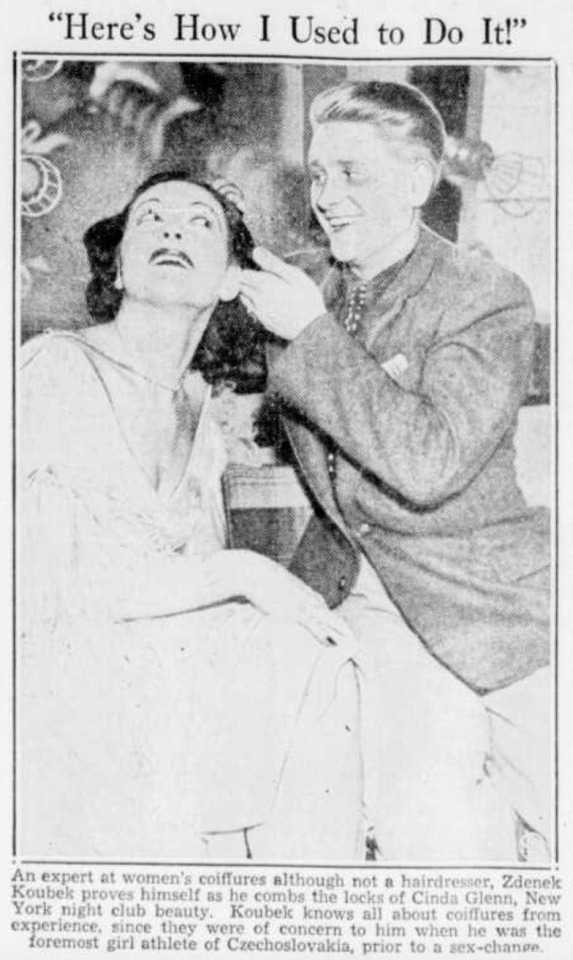
ID: a black and white photo and caption from a newspaper showing a young white trans man with light hair wearing a tweed jacket and high collar smiling at a young white woman in a pale dress as he brushes her mid-length dark hair. She is smiling at him from the slightly complex angle as he brushes her hair. The photo is faded and not great quality but their faces are clear.
The headline over the photo is “Here’s How I Used To Do It!”
The caption below reads “An expert at women's coiffures although not a hairdresser, Zdenek Koubek proves himself as he combs the locks of Cinda Glenn, New York night club beauty. Koubek knows all about coiffures from experience, since they were of concern to him when he was the foremost girl athlete of Czechoslovakia, prior to a sex-change.”
Zdenek Koubek was born in Paskov, Czechoslovakia (at the time) in December 1913, one of eight siblings, and competed as an athlete. With minimal formal training, he began running at age 17, decided to pursue it formally aged 19, and broke two world records at the 1934 world olympics.
Because queer and gender-diverse history is complex, I’m genuinely unsure if Zdenek was intersex. He seems to have been pretty gender-nonconforming when read as a woman in his early life and seems to have retired from athletics because he was harassed by people wanting him to undergo invasive “gender checks” after his gold medals at the 1934 Olympics.
Apparently the current obsession with “defining gender in sport” has roots back to the 1930s. Athletes competing in female athletics have been forced to undergo a variety of examinations for the purpose of declaring them “female enough”. They seem to have never been pleasant, appropriate, or anything other than invasive and dehumanising, and they seem to have always focused on a) defining gender by physicality b) defined that physicality in fairly arbitrary ways that are actually incredibly difficult to relate to anything objective, despite a veneer of scientific objectivity.
I can entirely see why the threat of such harassment would have caused Zdenek to decide an athletic or adjacent career wasn’t worth undergoing it, whether he personally believed himself to be intersex or whether we would recognise him as such today. The term “intersex” has many definitions, and is often challenged by medical professionals if it could potentially cover too many people - e.g. medical professionals have repeatedly challenged the term when used by AFAB people with PCOS, which can cause fertility issues, hirstutism etc, purely on the grounds of “that would make around 10% of women intersex”. Zdenek simply publicly stated “I was wrongly assigned as female at birth” without giving any other details - as he had *every* right to. Some historians have characterised him as intersex based on this, and others simply as trans; he appears, very reasonably, to have preferred to preserve his privacy on the details.
Zdenek went on a lecture tour of the US talking about his life and transitioned in 1936. At the time of this photo, he was pursuing a career in cabaret in the US. He seems to have been reasonably successful but never settled there, returning home and marrying a cis woman with whom he lived happily for the rest of his life, dying in Prague aged 72 in 1986.
He joined a local rugby team along with his brother Jaroslov after WWII and seems to have been an enthusiastic amateur player. I hope he got a lot of joy out of it, which he does seem to have.
Like so many queer and trans histories, Zdenek’s is somewhat obscured because so much of what has been written about him is always skewed by the writer’s own perspectives about gender and transness. Including the drive to impose a false binary on trans experience - which I as a nonbinary person know is certainly not universally present.
There are, of course, *absolutely* trans people who always have a strong feeling of gender equating to “knowing they are a boy/girl from an early age”, and I in no way wish to erase them or their experiences, but it must also be noted and acknowledged there are plenty of us with different experiences. There are people like me who feel “wrong” in our assigned gender from pretty early in life, all the way down to having quite strong dysphoria in puberty and afterwards, but don’t strongly ID as the “opposite” binary gender either. There are people who rub along fine in their assigned gender, or who have many issues with it but don’t know what they equate to, until they have some experience presenting otherwise and suddenly experience strong gender euphoria for the first time in their lives. There are people who never feel anything much at all about gender and only ever do any identifying purely as a matter of convenience because a very binary society requires it.
Cis people seem to find the “always knew/born in the wrong body” narrative the easiest to relate to, and I can only assume that is because it is the narrative that allows them to challenge our society’s gender-essentialist, binarist worldview the *least*. It is considerably easier, and requires much less thought and critical attention, to say “I guess sometimes the occasional person is just mistakenly assigned to the wrong category” than to question those categories, why they exist, what they actually are, how they are imposed, and whether they actually mean anything at all in an objective sense.
I have no idea where Zdenek fell on any of this, or if his experience was very different in another way.
I posted this to, as ever, note that we are not a new phenomenon. Trans people are part of human history. We have always existed. We have always contributed. The way the society we lived in perceived us *and* how the societies our stories have passed through perceived us affect how our stories are told today, and those things can make it complex to uncover the lived experience of the trans person behind all of that. Queer and trans history must always be about acknowledging those facts and uncertainties while doing our best to find out as much as possible about the actual lived experiences of our siblings in the past.
#trans#trans history#queer history#czech history#sports history#historiography#nonbinary#trans historian#nonbinary historian#queer historian#trans man#historical trans man#historical trans person#20th century history#modern history
99 notes
·
View notes
Text

Imagine running a marathon or playing football in heels just because some sexist men thought you weren’t being feminine enough👟
🏃🏻♀️⛹🏾♀️🚴🏽
#history#sneakers#sports wear#shoes#womens fashion#sports history#femininity#1920s#girl power#women empowering woman#athletes#womens history#sports#world war 2#athletic wear#sports attire#ww2#female athletes#womens shoes#fashion history#1940s#feminism#fitness#womens sports#women supporting women#nickys facts
36 notes
·
View notes
Text

#women in sport#women's sports#women's judo#women's history#sports history#martial arts#herstory#radfems please touch#radfems do interact#radfems do touch#radfems please interact#proud radical feminist#proud radfem
37 notes
·
View notes
Text
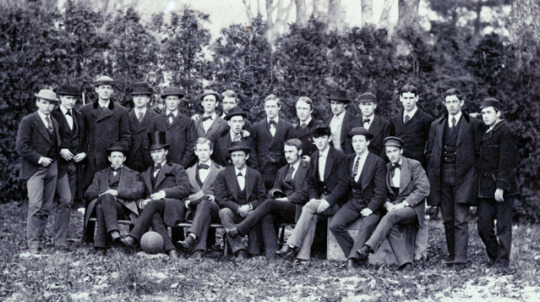
Although the first intercollegiate American football game was infamously played on Princeton's campus in 1869, for the first few years, it would have been unrecognizable as American football to most who know the game today. Samuel Cowart, Class of 1876, described an incident that occurred in a game with Yale on December 15, 1873, when the ball got caught between teams and popped when both sides kicked it at the same time:
“It was a spherical/heavy rubber ball, blown up with a key. They had to take a team of horses and go back to New Haven, in order to get another football.”
Photo: The 1873 Princeton football team with its round ball in front of the man in the top hat. Historical Photograph Collection, Campus Life Series (AC112), Box LP36, Image No. 2522.
#sports history#On This Day#1870s#football#American football#Princeton#Yale#quote#Princetonquote#OnThisDay#athletics#sports#Princetonsports
16 notes
·
View notes
Text

That's quite the news to wake up to. I don't think this is all that surprising to anybody, but it's still kind of surreal.
When Bill Belichick started coaching the Patriots, Bill Clinton was President of the United States, Pope John Paul II was the leader of the Catholic Church, Saddam Hussein was firmly in control of Iraq, NASA had three operational Space Shuttles, the Houston Texans were two years away from playing their first game in the NFL, and I was 20 years old and couldn't even legally buy a beer.
#Bill Belichick#New England Patriots#History#Sports#Sports History#NFL#National Football League#NFL Football#Belichick#Football
18 notes
·
View notes
Text
Timely Fashion Advisory:

Did you know that sweatpants were invented just around a decade after the Titanic sank?
Émile Camuset created them in the early 1920’s for his sports equipment company, the Le Coq Sportif. By the 1932 Olympic Games, sweatpants were everywhere!
Worn by icons like Eddie Tolan, legendary track and field sprinter and the first Black athlete to win two Olympic gold medals:

And the unstoppable Babe Didrikson Zaharias, a sporting polymath who excelled at track and field events, basketball, baseball and golf. She also took home two gold medals in 1932.
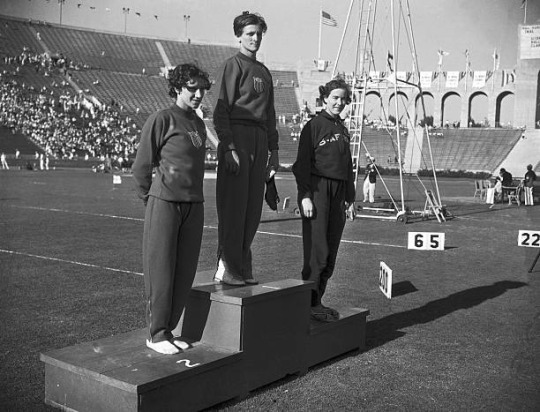
Sweatpants’ popularity exploded during the 1960’s fitness boom, and they’ve lived rent free in our closets and hearts ever since.
A hundred years after their invention, let’s celebrate our humble sweatpants!
Iconic. Comfortable. Highlighting assets while covering a multitude of sins.
V/r,
Agent Kay
#1900s#history#time travel#olympics#1932 Olympics#sweatpants#clothing#vintage fashion#fashion#fashion history#fitness#Eddie Tolan#Babe Didrikson Zaharias#track and field#sprinting#los angeles#sports#sports history#olympic games#sports legends
97 notes
·
View notes
Photo

When Sports Imitate Art: LJ Rader, the man behind @ArtButSports on Twitter, compares iconic images with art historical paintings, sculptures, and installations.
113 notes
·
View notes
Photo

She will always be my favourite skater.
#tonya harding#figure skating#ice skating#skating#coquette#dollete#i tonya#films#skate#triple axel#sports history
106 notes
·
View notes
Text
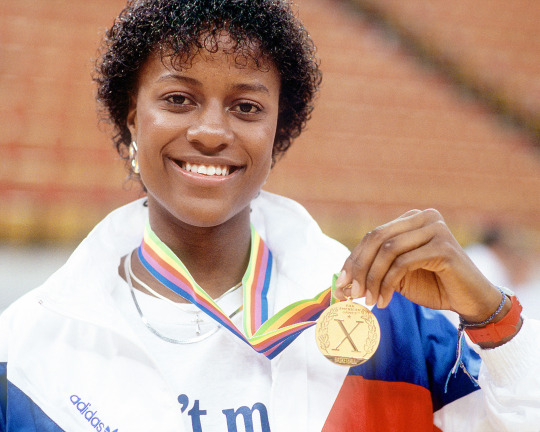
The WNBA Story: Pioneering Women’s Pro Basketball in the United States
The Women's National Basketball Association (WNBA) has a rich history dating back to its inception in 1996. Established as the women's counterpart to the National Basketball Association (NBA), the league has since set a standard for professional women's sports in the United States.

The first game of the WNBA was conducted on June 21, 1997, a face-off between the New York Liberty and the Los Angeles Sparks.

One of the pioneering teams of the league, the Houston Comets, left an indelible mark on the early years of the WNBA. The team secured the first four championships from 1997 to 2000.

Within the National Archives, records related to the WNBA offer fascinating insights into the league's evolution.

A team jersey and signed basketball from the Indiana Fever WNBA basketball team are on display in our exhibit, “All American: The Power of Sports."
#WNBA#Sports#Sports History#Women's Sports#Basketball#Women's Basketball#All American Exhibit#National Archives
68 notes
·
View notes
Photo

1921. Learning to ski in Núria (Comarques Gironines, Catalonia), before the zip train or the cableway were built.
Skiing was introduced to Catalonia in 1908. The first ski station was la Molina (High Pyrenees) and the second one was Núria. Both of them are still active ski stations.
Source: Revista Sàpiens.
#vall de núria#núria#catalunya#esquí#esport#història#ski#skiing#snow#1920s#vintage photography#old photo#old photography#europe#history#sport#sports#sports history#mountain#mountains#winter
53 notes
·
View notes
Text


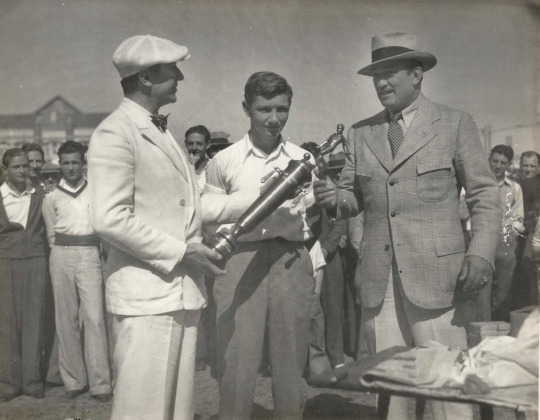
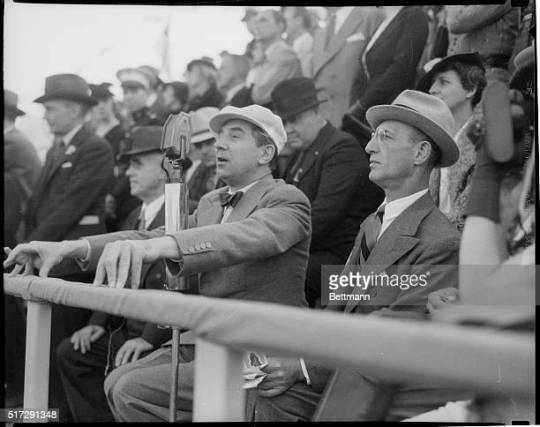
Some photos of Bela Lugosi at various soccer events. His wife, Lillian, is in the first photo wearing the dark hat.
Here's a quote from this article (which has lots of good info about the history of Hungary and soccer and Lugosi's involvement):
“Lugosi was an extremely cultured man and saw soccer as a means of promoting the vibrant Hungarian community in Los Angeles. He gave financial support to the Los Angeles Magyar team, acted as honorary president of the Los Angeles Soccer League for many years, and never lost an opportunity to encourage interest in the sport.”
26 notes
·
View notes
Text

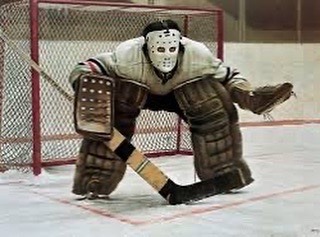




Hockey goaltending then vs now
#hockey infodumping time!!!#hockey#hockey tag#ice hockey#nhl#goalies#hockey goalies#nhl goalies#nhl players#carey price#marc andre fleury#<<<just cus they r in the pics#and they are tendies#sports#sports history#hockey equipment
205 notes
·
View notes